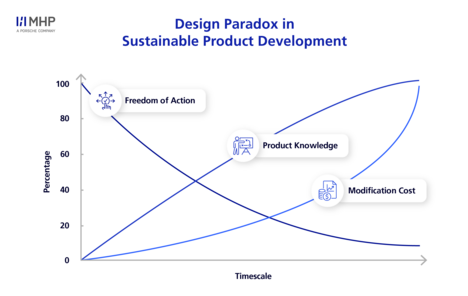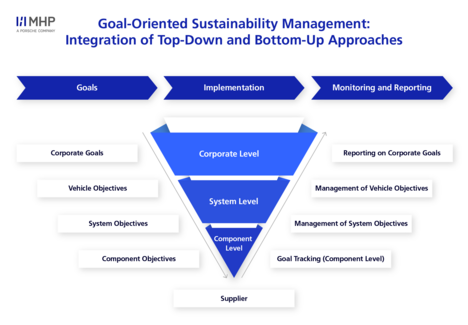
- Blog, Digital Transformation
- Published on: 09.09.2024
- 9:22 mins
Sustainable Product Development: Digital and Weight-Based Sustainability Control
Up to 80% of a product's environmental impact is determined in the early development phase – a figure that highlights how crucial product design is for sustainability.
Sustainability is not just a trend but a crucial factor for the long-term success and competitiveness of companies. To meet these demands, companies need to realign their product development in a holistic manner. A particularly effective mechanism for achieving sustainability goals is the integrated consideration of weight and sustainability management.
By closely integrating the two disciplines, connections and dependencies can be identified, allowing for targeted management of weight-related product characteristics and thereby significantly improving sustainability performance.
In this article, discover how integrating weight data into your sustainability management can enable precise actions to enhance your ecological footprint while meeting market and regulatory requirements.
Relevance of Sustainability and Weight Management for OEMs
Integrated and effective business sustainability management is indispensable for companies in the automotive and aerospace industries. In both sectors, considering product weight from a sustainability perspective plays a central role in ensuring compliance with regulations and positively impacting the ecological footprint.
Furthermore, weight is a crucial factor in the aerospace and commercial vehicle sectors in terms of payload ratios for companies. The lighter the vehicle's own weight while maintaining the same maximum allowable weight, the greater the payload capacity, potentially leading to higher profits for customers through increased cargo capacity. In the passenger car sector, lower weight often helps meet performance expectations. However, effective weight reduction can not only optimize driving dynamics but also reduce fuel consumption simultaneously.
Regardless of the industry, it is essential to achieve a balanced ratio among qualitative requirements, constructive applications, financial costs, and ecological compatibility when selecting and using raw materials and components. This balancing act is challenging but ultimately worthwhile in the long run.
Sustainable Product Development: These Are the Challenges
Companies that want to implement weight-based control of sustainability performance face a variety of challenges in product development.
Design Paradox
Determining weight and calculating the CO₂ footprint throughout the entire project lifecycle is very complex. Especially in the early stages of product development, forecasts and calculations are challenging due to often insufficient data. While changes can be implemented more easily and cost-effectively during this phase, relevant information for making informed decisions is often lacking. This leads to the so-called design paradox: As product development progresses, the available information becomes more comprehensive, but simultaneously, changes become increasingly complex and costly.
Managing Conflicts of Requirements in Weight and Sustainability Management
A central solution approach from MHP is the integration of the three disciplines: weight management, sustainability management, and digitalization. This holistic approach enables companies to more effectively balance lightweight construction and sustainability. While lightweight materials can improve a product's environmental footprint due to their weight advantage, they are not always sustainable or recyclable. MHP's integrated strategy enables the transparent resolution of conflicting objectives, facilitating informed decisions that balance ecological and functional requirements.
Integrating recycling processes and increasing the proportion of recycled materials in products pose additional challenges. Companies must act in line with a circular economy and find ways to effectively reuse materials. At the same time, they must maintain the quality and functionality of their products. A digitized weight management system is essential for calculating and subsequently reducing emissions and recycling rates.
Legal Framework
Companies face the challenge of complying with a growing number of increasingly stringent environmental regulations. In addition to the overarching EU Green Deal, specific regulations like the Corporate Sustainability Reporting Directive (CSRD), the End-of-Life Vehicle Regulation, and the Ecodesign Regulation must also be taken into account. These regulations require extensive changes in development, production, supply chain management, and reporting, which necessitates additional resources and investments. Compliance with these regulations is crucial not only to avoid legal penalties but also to achieve the company’s sustainability goals.
Positioning the Digitization of Weight Management within the Overall Context of Sustainability Management
The integrated consideration of weight and sustainability management is a strategic approach that enables precise calculation of the impacts on sustainability performance through the provision of reliable weight information for components and products.
The transparent weight serves as a crucial decision-making tool for determining the focus of a component: sustainability, cost, design, or weight. This ensures that material use is optimally planned without compromising the quality or functionality of the products.
Weight management spans all phases of product development. It starts in the early development phase, continues through the conceptual phase, and extends to series monitoring.
The main objectives of weight management are to define the weight targets, continuously track weights from various departments, and ensure adherence to these weights. Additionally, weight management includes reviewing and complying with legal requirements related to weight.
In this context, weight management plays a central role in sustainability management. A lower product weight generally means reduced CO₂ emissions, as less material needs to be processed during manufacturing and transported during the usage phase. This has direct, positive effects on a company’s environmental footprint. Additionally, digitalization facilitates an effective integration of weight and sustainability management. A digitized weight management system provides the essential input for sustainability management, enabling informed decisions to achieve sustainability goals.
The Benefits of Weight-Based Sustainability Management
Overall, weight-based sustainability management requires a holistic approach and a willingness to invest in innovative solutions. Companies that successfully tackle these challenges can not only improve their environmental footprint but also strengthen their competitiveness and position themselves successfully in the market over the long term.
Even though the hurdles may seem quite challenging at first glance, it is worth tackling them for your company. On one hand, weight-based sustainability management significantly contributes to environmental protection by minimizing resource consumption and reducing emissions. This also has the positive side effect of potentially lowering production and transport costs, leading to substantial cost reductions. On the other hand, the use of IT solutions specifically designed for managing and controlling sustainability goals provides companies with a competitive advantage. Simultaneously, they adopt the "Green by IT" approach, which involves leveraging IT solutions to optimize sustainability performance. By using IT, companies can perform more precise analyses, create transparency, and collect more accurate data, enhancing their ability to achieve sustainability goals. This targeted improvement in sustainability performance through effective IT use can significantly distinguish them from their competitors.
Another significant benefit is the support for regulatory compliance. Many countries and organizations are increasingly enforcing stricter environmental laws and regulations, which can be more easily met through weight-based sustainability management. At the same time, your company can address the growing demand from customers for environmentally friendly products in their tenders. By recognizing this trend and producing sustainably, you can better meet customer expectations and strengthen your position in the market.
How MHP Can Support Your Weight-Based Sustainability Performance
At MHP, we are a dedicated partner in implementing weight-based sustainability management. Our experts will collaborate with you to create a customized solution designed specifically for your company’s needs.
1. Goal Definition
In the first step, it is essential to either align your sustainability goals with the company’s overarching objectives or derive them from these goals. This top-down approach ensures that sustainability goals are clearly defined and translated into actionable targets at the vehicle, system, and component levels. This process clarifies how each area can contribute to achieving the overall objectives.
Next comes the bottom-up approach to product development. Here, specific sustainability data, such as recycling rates and CO₂ emissions, are collected directly at the component level. This data is then aggregated to track progress at the system and vehicle levels, ensuring that the defined company objectives are met. By continuously reporting at the vehicle, system, and component levels, your company keeps track of the current status and progress toward achieving goals throughout the entire product development process. This allows for prompt actions to be taken, ensuring effective optimization of sustainability performance.
2. Process and IT Tool Requirements
To implement these measures effectively, coordinated and aligned requirements for process and IT tools are essential. MHP assists you in defining company-wide requirements for your processes and IT tools, involving all relevant stakeholders, and integrating the process and tool landscape into your corporate architecture. This also enables you to hold your suppliers accountable and consider weight and sustainability measures alongside quality and cost when awarding contracts.
3. Implementation of Digitalization Solutions
A rigorous digitalization of process mapping and execution is crucial for managing sustainability performance successfully in the long term and for taking timely action in case of deviations. MHP brings extensive expertise and experience to the development of such solutions, tailored specifically to the needs of your company.
4. Compliance-Management
MHP ensures that your sustainability strategy complies with the latest regulatory requirements. We support you with the documentation and reporting of the necessary sustainability data. Additionally, we provide proactive management to ensure regulatory compliance and prepare for future legal requirements.
Enhancing Sustainability Performance through Integrated Weight Management and Digitalization
Weight-based control of sustainability performance is a key lever for meeting the growing demands for environmental protection and resource efficiency. By integrating weight data into sustainability management, companies can precisely track their ecological goals while also achieving economic benefits. Given that predicted weight frequently changes during the development process, a comprehensive digital solution is essential for efficiently managing these changes in sustainability and responding appropriately.
This approach enables the reduction of CO₂ emissions, optimization of material usage, and efficient compliance with regulatory requirements. Companies that successfully implement this strategy are better equipped to tackle future challenges and secure their market position in the long term.
FAQ
Weight management significantly impacts sustainability performance by enabling precise measurement and continuous tracking of weight information throughout the entire development process. By providing accurate weight data, companies can effectively manage their sustainability goals and make informed decisions that consider both ecological and economic aspects. This ensures that sustainability measures are implemented efficiently and adapted to actual conditions. As a result, emissions during production and transport are reduced. Additionally, it facilitates compliance with regulatory requirements and improves a company's environmental footprint by minimizing the product's CO₂ footprint over its entire lifecycle.
Digitalization plays a crucial role in integrating weight and sustainability management. Comprehensive IT systems connect these disciplines and provide the input necessary for sustainability control, enabling companies to implement precise and efficient measures to improve their environmental footprint. By leveraging digital technologies, weight data can be captured and analyzed, which facilitates optimized resource planning and usage. This helps reduce material consumption and minimize CO₂ emissions.
Companies can ensure their products meet the latest sustainability standards by adapting their development processes and implementing modern digital solutions. This includes integrating weight data into sustainability management to take precise and efficient actions to improve the environmental footprint. Additionally, companies must regularly analyze and adjust their supply chains and production processes to optimize resource use and reduce CO₂ emissions. Compliance with regulations such as the Ecodesign Regulation can be facilitated through effective weight-based sustainability management. Collaboration with experts and the use of innovative IT tools are crucial for continuously adapting to the latest standards.







